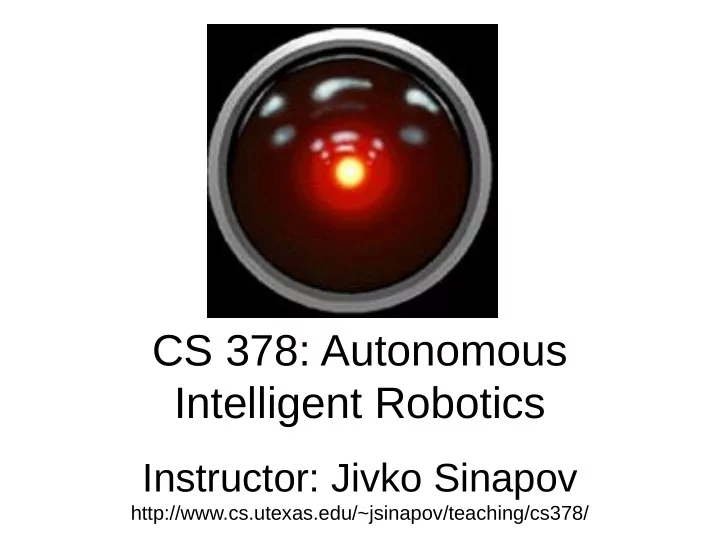

CS 378: Autonomous Intelligent Robotics Instructor: Jivko Sinapov http://www.cs.utexas.edu/~jsinapov/teaching/cs378/
The Sense of Touch
Announcements
Remember this?
Announcements
Project Deliverables • Final Report (6+ pages in PDF) • Code and Documentation (posted on github) • Presentation including video and/or demo
Readings for next week As before, your pick.
The Sense of Touch
Overview of Haptic Sensing “The haptic system uses sensory information derived from mechanoreceptors and thermoreceptors embedded in the skin (“ cutaneous ” inputs) together with mechanoreceptors embedded in muscles, tendons, and joints (“ kinesthetic ” inputs).”
Meissner corpuscle Merkel cell complex Ruffini ending Pacinian corpuscle
Properties of Mechanoreceptors • Relative size of receptive field – Small vs. Large • Relative adaptation rate – Response to onset/offset of skin deformation vs. continued response during sustained skin deformation
Meissner corpuscle Merkel cell complex Ruffini ending Pacinian corpuscle
Measuring Spatial Acuity
Measuring Spatial Acuity • Two-point touch threshold: – Represents the smallest spatial separation that can be detected some arbitrary percentage of the time
Measuring Spatial Acuity distinguishable indistinguishable
Temporal Resolving Capacity • People can resolve a temporal gap of 5 msec between successive taps on the skin • The temporal resolving capacity of skin is better than that of vision but worse than that of audition
How do people use haptic / tactile sensations to perceive objects?
Exploratory Procedures Contour Lateral Enclosure Pressure Following Motion Unsupported Part Motion Test Static Contact Insertion Holding [Lederman and Klatzky, 1987]
Object Properties • Material properties: – Surface texture, compliance, thermal quality • Geometric Properties: – Shape and size • The weight of an object reflects both its material density and its size
[Power, 2000] [Lederman and Klatzky, 1987]
The Sense of Touch: A Case Study with a Robot
Sinapov, J., Sukhoy, V., Sahai, R., & Stoytchev, A. (2011). Vibrotactile recognition and categorization of surfaces by a humanoid robot, IEEE Transactions on Robotics, 27(3), 488-497. http://home.engineering.iastate.edu/~alexs/lab/publications/papers/IEEEtran_Robotics_2011/IEEEtran_Robotics_2011.pdf
The Vibrotactile Sensory Modality
Merkel cell complex
Can a robot use the vibrotactile sensory modality to recognize surface textures?
Artificial Finger Tip
Artificial Finger Tip
Full Setup
Exploratory Behaviors
Exploratory Behaviors
Surfaces
Control Condition • The 21 st “surface” consisted of scratching in mid-air
Data Collection • Each scratching behavior was performed on each surface a total of 10 times • This produced a total of 5 x 21 x 10 = 1050 behavioral interactions • Each surface was changed after the robot scratched it once with all five exploratory behaviors and not scratched again until the robot scratched all other surfaces
Signal Processing Pipeline
Signal Processing Pipeline
Signal Processing Pipeline Magnitude vector: Magnitude deviation vector:
Signal Processing Pipeline
Signal Processing Pipeline Spectrogram of Magnitude Deviation Vector
Signal Processing Pipeline 200 Hz 4 Hz Spectrogram of Magnitude Deviation Vector
Signal Processing Pipeline
Surface Recognition Formulation • Given a sensory signal, estimate the probability that a given surface was present, i.e.:
Machine Learning Models k-NN: memory-based learning algorithm With k = 3: 2 neighbors 1 neighbors Test point ? Therefore, Pr(red) = 0.66 Pr(blue) = 0.33
Machine Learning Models • Support Vector Machine: a discriminative learning algorithm 1. Finds maximum margin hyperplane that separates two classes 2. Uses Kernel function to map data points into a feature space in which such a hyperplane exists [http://www.imtech.res.in/raghava/rbpred/svm.jpg]
Machine Learning Models
Surface Recognition Rate for a Single Behavior
Surface Recognition Rate for a Single Behavior
Surface Recognition Rate for a Single Behavior Chance accuracy = 5 %
Can we improve the recognition of surfaces after applying all 5 behaviors?
Can we improve the recognition of surfaces after applying all 5 behaviors?
Can we improve the recognition of surfaces after applying all 5 behaviors?
Summary of Results
Latest and Greatest in Tactile Sensing Fishel, Jeremy A., and Gerald E. Loeb. "Bayesian exploration for intelligent identification of textures." Frontiers in neurorobotics 6 (2012).
The BioTac Artificial Finger Fishel, Jeremy A., and Gerald E. Loeb. "Bayesian exploration for intelligent identification of textures." Frontiers in neurorobotics 6 (2012).
Surface Texture Exploration Setup Fishel, Jeremy A., and Gerald E. Loeb. "Bayesian exploration for intelligent identification of textures." Frontiers in neurorobotics 6 (2012).
Surface Recognition using Bayesian Inference
Active Selection of Exploratory Movements • Using prior estimates of pair-wise surface confusion, select the behavior that is most likely to be informative and/or resolve the current ambiguity
Surface Texture Recognition Results
Surface Texture Recognition Results
The Skilsense Project
The Roboskin Project
Sensory Substitution
Other ongoing projects: • Skilsens: – http://www.youtube.com/watch?v=FQkC-gJGKmw • RoboSKIN: – http://www.youtube.com/watch?v=yQGXYGS0Ojo • In the news: – http://www.youtube.com/watch?v=49KmS0IkyW8 – http://www.youtube.com/watch?v=APTNpGZ7mWc
THE END
Recommend
More recommend